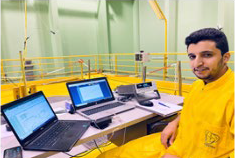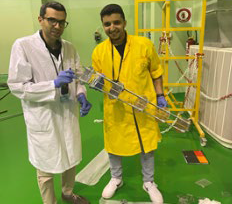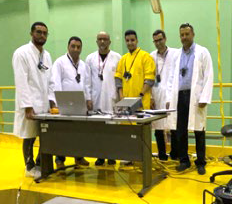Advanced neutron and photon flux characterization in the irradiation channels of the CNESTEN’s TRIGA Mark II reactor.

|

|

|
| Nom | Laboratoire | Mobilité | Pays | Laboratoire |
|
Hamza Ghninou 
|
IM2NP/CEA | 2 mois | Rabat, Maroc | CNESTEN, Centre National de l'Energie, des Sciences et des Techniques Nucléaires |
As a third-year Ph.D. candidate, I am working on the experimental characterization of the irradiation channels of the CNESTEN1’s TRIGA Mark II research reactor located in Rabat, Morocco. This type of reactor is specially designed to effectively implement the various fields of nuclear research such as Neutron Activation Analysis, education and training, Neutron Radiography, Detectors testing and radioisotopes production. During my PhD first year, I developed a complete computational model of the TRIGA reactor using the 3-D continuous energy Monte-Carlo code TRIPOLI4® in order to support planning, design and implementation of new experiments within and beyond the reactor core. Moreover, during my first Ph.D. year, measurements based on neutron activation technique, were carried out in order to characterize the neutron flux in different irradiation channels of the CNESTEN’s TRIGA reactor. The latter study was carried out as part of the bilateral collaboration between the French Atomic Energy and Alternative Energies Commission (CEA) and the CNESTEN. This collaboration has been established in order to accurately characterize the irradiation and instrumentation channels of the CNESTEN’s TRIGA reactor. Therefore, the work carried out during my thesis should make it possible to extend the experimental validation base of the CNESTEN TRIGA calculation scheme, by proposing, carrying out and analyzing experiments to characterize the neutron and gamma fields at different locations. A critical analysis of this computational model will then be carried out in order to improve its performance with regard to the important parameters during the qualification of nuclear instrumentation.
In January 2022, ISFIN has agreed to finance my mobility project to the CNESTEN. The project as built and presented in the proposal will allow me, on the one hand, to improve and strengthen my scientific and technical skills by carrying out and follow up closely new experiments in the reactor (neutron activation technique, ionization chamber measurements and nuclear heating measurements). On the other hand, spending 6 weeks interacting and scientifically exchanging with the nuclear experimental reactor team/community at the CNESTEN will be a great opportunity for me to develop disciplinary and inter-disciplinary skills in the nuclear instrumentation and it will inevitably have an eminent impact, a capital gain and a benefit on my PhD work.
Through this mobility project, I was able to conduct an experimental campaign combining different nuclear measurement methods and techniques that will enable me to strengthen the knowledge of neutron and photon flux within and around the reactor core. Eventually, the characterized irradiation positions will be used, firstly, to validate the computational model of the reactor and, secondly, to both test and calibrate innovative nuclear instrumentations before their implementation in nuclear power plants, and to carry out experiments allowing the improvement of existing knowledge on fundamental parameters in nuclear physics.
I would like to thank the Institut Sciences de la Fusion et de l'Instrumentation en environnements Nucléaires (ISFIN) for funding this mobility project. I would also like to thank the members of the CNESTEN’s TRIGA reactor, for providing suitable working conditions and for their valuable technical support to carry on the experiments in the reactor.

